Barão de Melgaço
Location and History
The main township in the region was originally known as Melgaço, after the Portuguese word melgas referring to the muddy pools which were common there. It later became known as Barão de Melgaço in honour of Admiral Augusto Leverger - a hero of the Paraguayan War who commanded forces based in the town, and who was later made a Baron by Brazilian Emperor Dom Pedro II.
The town is located 130km from Cuiabá and has a population of about 8,000. It's situated on a hill called the Morro Chacororé - which becomes an island in the wet season, surrounded by water. This hill was fortified during the Paraguayan War, with preserved relics such as cannons and trenches still remaining.
The wider Barão de Melgaço Pantanal sub-region makes up around 13% of the Pantanal, with an area of 18 503 km².This covers the territory between the Cuiabá river and Piquiri/Itiquira rivers - and is dominated by rivers and two large lakes (Baía Chachororé and Baía Sinhá Mariana). This area floods significantly during the wet season - with around 90% of the region underwater.
Indigenous History
There are numerous archaeological sites spread across the region with rock paintings and carvings. Some of these date back around 8,000 years. The region remains home for the Bororo indians (also known as the Coroado or "crowned" indians because of their impressive headresses), who have a rich culture and history. Although they've had good relations with Europeans in more recent years, they suffered through a long period of conflict in which most of their lands were lost and the westerns tribes were wiped out. During this period they earned a reputation as brave and extremely fierce warriors. The Bororo still preserve many of their traditions, including hunting for fish with bow and arrow.
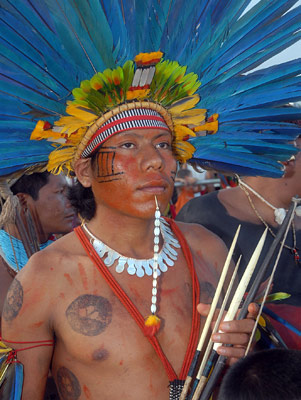
Bororo-Boe youth during Brazil's ninth Indigenous Games. Credit: Valter Campanato/Agência Brasil
Wildlife
Although visitors report that animals are less readily seen than in the neighbouring Poconé region (possibly due to the wetter landscape), Barão de Melgaço still has the usual Pantanal wildlife. The slightly different landscape of each Pantanal sub-region simply means that you'll get a different mix of animals and birdlife (noting that this also varies by season). This is why visitors are encouraged to visit multiple locations if they want the full Pantanal experience.
One of the best spots to see wildlife is Ninhal Porto da Fazenda. This is a large breeding colony of birds (with herons, cormorants, and roseate spoonbills) which is located along the Cuiabá river - mid-way between Barão de Melgaço and Porto Cercado. This can be reached via a two-hour boat journey. Organised tours maintain a safe distance (around 80m) to minimise disturbance.
Among local Brazilians, the Barão de Melgaço region is famous as a fishing hotspot for fishing - and many tourist lodges are set up primarily for this purpose. Fish commonly found in the region's lakes and rivers include several species of very large catfish (Jaú, Pintado and Cachara), plus Piranha, Pacu (a large fruit-eating relative of the piranha), Piraputanga, Cachorra, Piranha, and the highly-prized Dourado. Aside from recreational anglers, there are several large traditional fishing communities also within the region.
Baía Chachororé and Sinhá Mariana
These two lakes are located close to the main town. Baía Chachororé is the biggest - measuring around 15km across, whereas Baía Sinha Mariana is only around 8km across. Both are fairly shallow - hence the name Baía (meaning Bay or Pond) rather than Lagoa (Lake). Both lakes are good for fishing - and also attract large numbers of jacaré and wading birds.
Sadly, the larger of these two lakes is drying out. This is partly due to a canal built to link the two lakes and make it easier for navigation in the dry season. However, the larger of the two lakes sits around a metre higher - causing a significant drop as the two equalize. Issues have also occurred with the silting up of local rivers.
The lake's low water level has also reduced its flood level in the wet season. High flood waters provide a conduit allowing millions of newly spawned fish to enter the lakes from the nearby Cuiabá river - with the lakes serving as a natural fish nursery during the dry season. Lower flood levels have impeded this migration, resulting in lower fish stocks overall. This has in turned reduced the presence of other animals. Brazil's environmental agency (IBAMA) has recently erected a barrier to help guarantee a minimum lake level, and other work is underway to unclog the silted rivers which provide the lake's source. This will hopefully lead to environmental recovery over the longer term.
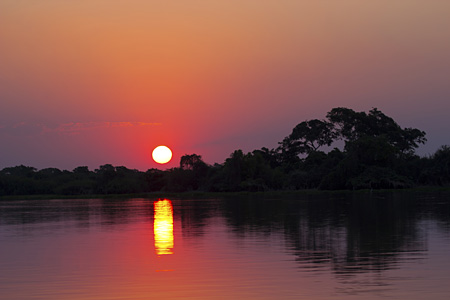
Sunset over Baía Sinhá Mariana in Barão de Melgaço. Credit: Shutterstock/Roberto Tetsuo Okamura
Marechal Rondon Birthplace and Memorial
Within the Barão de Melgaço region, the small village of Mimoso is notable as the birthplace of Marechal Cândido Rondon. Rondon is one of Brazil's more respected and revered historical figures. Most towns and cities have big avenues named after him - in addition to the town of Rondonópolis and the state of Rondônia. Rondon played a key role opening the Brazilian interior in the early part of the 20th Century planning and constructing telegraph services across Mato Grosso and neighbouring states. He guided US President Theodore Roosevelt on his own famous Amazon expedition (discovering what became known as the Roosevelt river). But, perhaps most importantly, Rondon was the founder of Brazil's Indian Protection Service. He provided the example and the philosophy which he summed up as "Die if necessary, but never kill". He proved that it was possible to make peaceful contact, and preserve the dignity and traditions of indigenous people - giving them a gradual transition into the modern world. This philosophy was subsequently adopted by the Villas-Boas brothers who established the world famous Xingú reserve in the Amazon territory of northern Mato Grosso - and is still the basis for first contacts with remote Amazon tribes conducted today by Funai.
In 2000, construction began on a memorial complex. This was intended to house an education centre, Rondon's personal collection of papers and artefacts - and a mausoleum allowing his body to be repatriated to the region. It was also to provide a centre for tourism related activities providing jobs and development to benefit the local community.
The metal skeleton was erected (at a cost of one million reais) - but then construction was stopped without explanation. The incomplete skeleton has remained abandoned for the last decade. Instead of the planned monument one of Brazil's (and the region's) great heroes, it has become monument to government incompetence, broken promises and corruption. In early 2013, it seemed that things would finally get back on track when the the state governor, Silval Barbosa, promised to restart construction and to have the complex complete in time for the 2014 Football World Cup (due to to games being played in nearby Cuiabá) - but this also didn’t occur. Some construction was restarted in January 2015, but as at June 2015 only about 3% of the work had been completed. Notably, the now-former state governor has been arrested for corruption along with his wife, accused separately of diverting money from social assistance programs. Roseli Barbosa was reputedly responsible for a now-infamous state-funded tourism training package that openly insulted Barão de Melgaço and other small towns in the state.
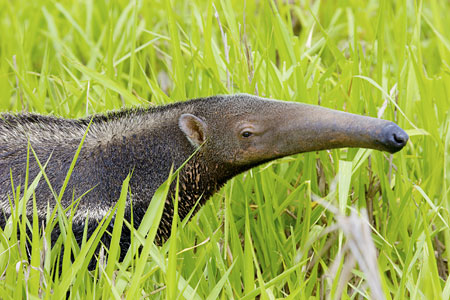
Giant anteater wandering through the tall grasses of Barão de Melgaço. Credit: Shutterstock/Roberto Tetsuo Okamura
Getting There
By Car: Travel out of Cuiabá along the BR-364 (which is also the BR-070 and BR-163). Continue past the turn-off to Santo Antonio de Leverger until you reach MT-361. Turn right and travel along MT-361 for around 40km. Alternatively, you can travel via Santo Antonio de Leverger along MT-456. The distance between these towns is about 60km.
By Bus: There are generally two buses (a morning and an afternoon bus) travelling each day between Cuiabá and Barão de Melgaço.
For Bus travel to other centres such as Rondonópolis and Jaciara:
By Air: Commercial flights from most other Brazilian cities fly into Cuiaba. In most cases travel to Barão de Melgaço will require a rental car or other land transport (e.g. a shuttle arranged by your lodge). However, if you're planning to travel to a remote lodge in the interior of the region (and particularly in the wet season when roads are most difficult), an aero-taxi from Cuiabá might by the most practical way to travel. If so, this is best planned and arranged through your lodge.
By Boat: River transport can be arranged travelling to Barão de Melgaço along the Cuiabá river. We're not aware of any regularly scheduled services but these can be arranged locally including as part of packages offered by some tour companies. Some of these may be Barco-Hotels (hotel vessels) used for fishing tours.
Things to See and Do
Barão de Melgaço
Fishing
Fishing is one the big attraction for most Brazilians who visit the region.Most lodges are set up to cater for the needs of the sports fisherman - with boats and guides to take you to the best fishing spots. The best time for fishing is the dry season when the first are more concentrated (and hungrier). Regional varieties include large catfish (such as jaú and pintado), pacu and dourado.
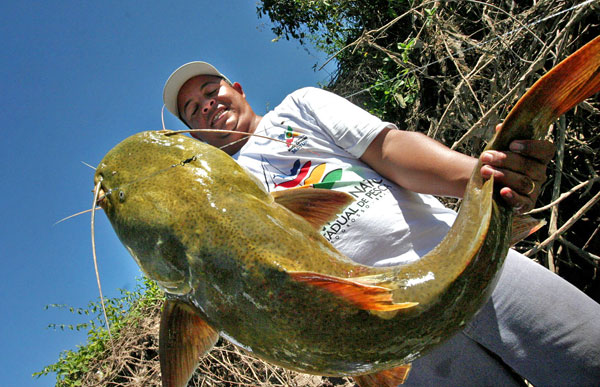
The region of Barão de Melgaço is a popular spot for sports fishing, offering impressive specimens such as this Gilded Catfish (Jaú). Catch and release fishing is strongly encouraged . Credit: Guilherme Filho\Secom-MT
Boat Journey
With many lakes and rivers throughout the region, boats are one of the best (and most comfortable) ways to explore and to see the local wildlife. Animals (most notably jacarés and capybara) can often be seen resting along the water's edge - along with numerous species of bird such as: skimmers, spoonbills, falcons, parrots, herons, and kingfishers
Horse Trekking
Horses are another primary modes of travel within Barão de Melgaço. They handle the terrain even better than a 4WD. This is also a great way of getting close to wildlife since most other animals will see the horse - but not notice the person riding on its back. Most lodges tour lodges will be happy to organise short horse treks. For the more adventurous, the region's annual Cavalgada takes place every June and is a big event on the local calendar. This is a four-day horse trek travelling from the main town towards to the remote community of São Pedro de Joselândia. This trek crosses the Pantanal countryside including several rivers.
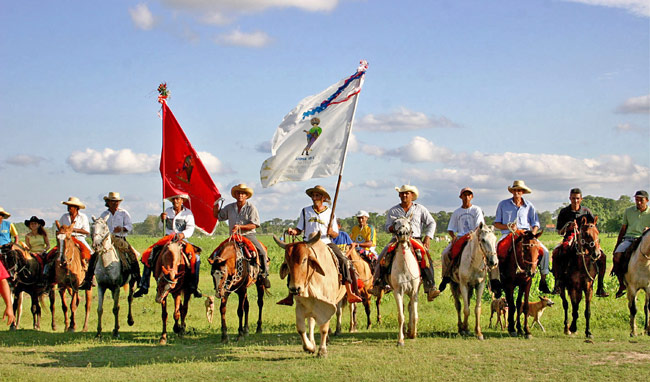
Getting around in the remote community of São Pedro de Joselândia, in the district of Barão de Melgaço. Credit: Guilherme Filho/Secom-MT
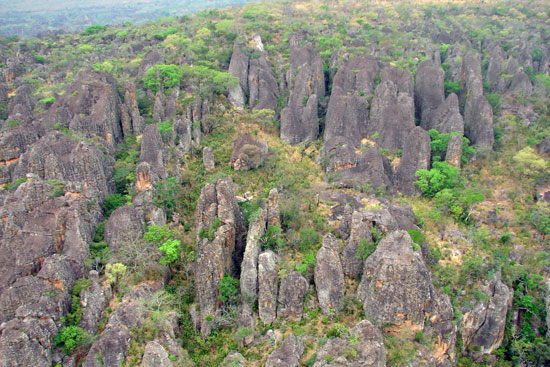
Arial view of Cidade das Pedras within the João Basso Ecological park outside Rondonópolis. Credit: Assessoria
Rondonópolis
Rondonópolis is Mato Grosso's third biggest city, with a population of around 200,000 people. It's grown rapidly in recent year thanks to agriculture and (especially) the boom in soya beans - attracting a influx from many other Brazilian regions. Local tourist attractions are centred around the João Basso Ecological Park area outside the city.
- Cidade das Pedras (City of Stones). Located about 70km outside the city, this is an area of natural rock formations. It also harbours pre-historic rock paintings and archaeological sites which have been dated to around 9,000 years old. The area is open to visitors through a series of guided trails.
- Rio Ponte de Pedra. Located about 4km out of the city, this is location for adventure sports such as rafting and rappelling down waterfalls.
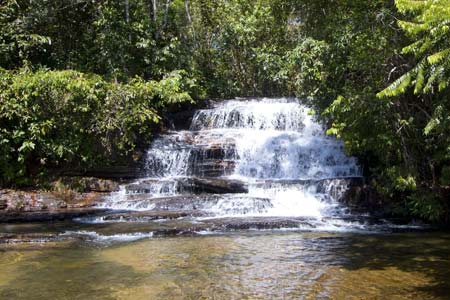
The town of Jaciara has several picturesque waterfalls. These are popular spots for picnics, swimming, and adventure sports such as whitewater rafting. Credit: Shutterstock/Roberto Tetsuo Okamura
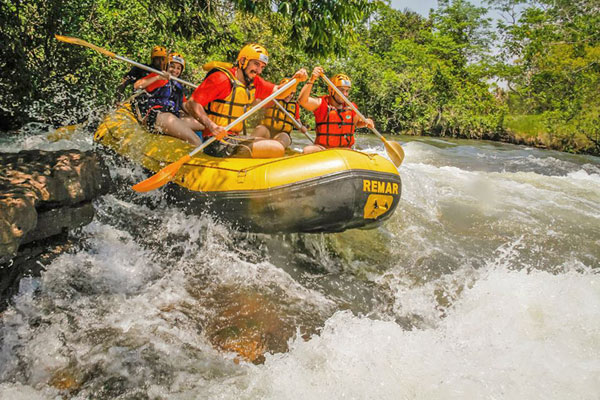
Rafting on the Tenente Coronel Amaral river, near Jaciara, is a great option for adventure seekers. Credit: Tony Ribeiro
Rafting and Waterfalls in Jaciara
Jaciara is famous in the region for it's white water rafting (level 2 to 4) and other adventure sports. These occur on the Tenente Amaral river, and there are several professional operators providing the necessary equipment and expertise.
The nearby 40m high Cachoeira da Fumaça waterfall is also well worth a visit. Vale das Perdidas (Valley of the Lost) is an archaeological site containing prehistoric rock paintings. The site was discovered by french researchers in 1984 and can be accessed via guided trails. These are located on a private farm and there is a small entry fee to assist the upkeep of the trails.
Caving in the Caverna que Chora (Crying Cave) is another worthwhile option. Visitors can descend about 500m into the cave viewing stalagtites and stalagmites. A guided journey within the cave takes about about two hours.
Thermal Pools in Juscimeira
Nearby, the town of Juscimeira has thermal pools which are perfect after a day of rafting, and as well as more picturesque waterfalls such as Cachoeira da Mulata, Cachoeira Mirandopolis, Cachoeira do Bispo, and Cachoeira do Prata.
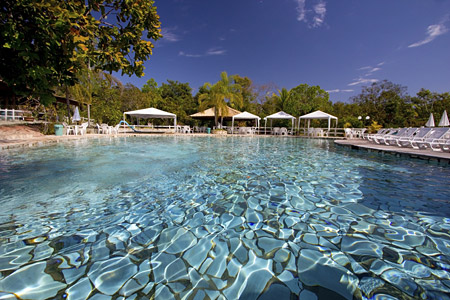
Balneario Thermas Cachoeira da Fumaca in Jaciara. Credit: Shutterstock/Roberto Tetsuo Okamura
Places to Stay - Jaciara/Juscimeira
Name
Description
Pousada Aquarius
Rua Sete de Setembro, Juscimeira
Facebook Page
Pousada with thermal pools and a park setting.
No reviews available
Pousada Fazenda JR
Rodovia do Prata, Km 3.5, Juscimeira
Facebook Page
Rustic pousada in a rural setting. Outside of town.
No reviews available
Pousada Rosa dos Ventos
BR-364 Km 277, Jaciara
www.pousadarosadosventosmt.com.br
Comfortable pousada outside of town catering for those with an interest in the region's adventure sports.
See Trip Advisor reviews.
Taba Hotel
Av. Bororos, 183, Jaciara
www.tabahotel.com.br
Established hotel. Comfortable and able to assist with tours and adventure sports.
See Trip Advisor reviews.
Thermas Hotel Mariha
Av. Juscelino Kubitschek, 10, Juscimeira
www.aguasquentesmariha.com.br
Large hotel with including meeting rooms and facilities for business travellers.
See Trip Advisor reviews.
Name
Description
Pousada do Rio Mutum
Mimoso-Capoeirinha Km 15, Barão de Melgaço
www.pousadamutum.com.br
Stylish and well-reviewed Pousada close the historic town of Mimoso and the Pantanal lakes of Baía Chachororé and Baía Sia Mariana. Good reputation for wildlife, birdwatching and fishing.
See Trip Advisor reviews.
Pousada Baguari
Mimoso-Capoeirinha Km 13, Barão de Melgaço
www.pousadabaguari.com.br
Close to Pousada do Rio Mutum. Not ideal for wildlife.
See review.
Pousada da Tia Feva
Palmiro Paes de Barros, 4, Barão de Melgaço
www.pousadatiafeva.com.br
Not a Pantanal Lodge, but used by some fishing tourists. Simple pousada within the township of Barão de Melgaço.
No reviews available.
Hotel Fazenda Arara Azul
Pirigara River
www.hotelfazendaararaazul.com.br
Comfortable (though remote) lodge for fishing and wildlife located on the Pirigara River, a tributary of the São Lourenço. Access is by plane or by boat.
No reviews available.
Pesqueiro e Pousada Piquiri
North bank of Piquiri river on MT/MS border (near Sonora)
www.pousadapiquiri.com.br
Remote fishing lodge on the border with Mato Grosso do Sul. No direct road access. Access is 45 mins by boat from Porto Jofre, or by air taxi from Cuiabá.
See Trip Advisor reviews.



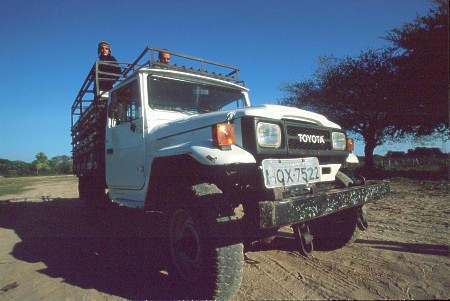
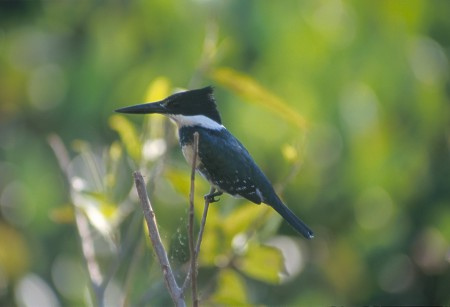
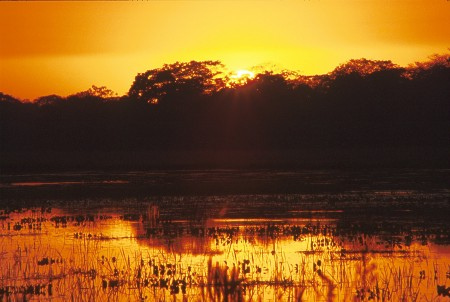


Banner: Cocoi heron flying over river in Barão de Melgaço region. Shutterstock/Roberto Tetsuo Okamura).
Footer images: Andrew Mercer
Pantanal Escapes